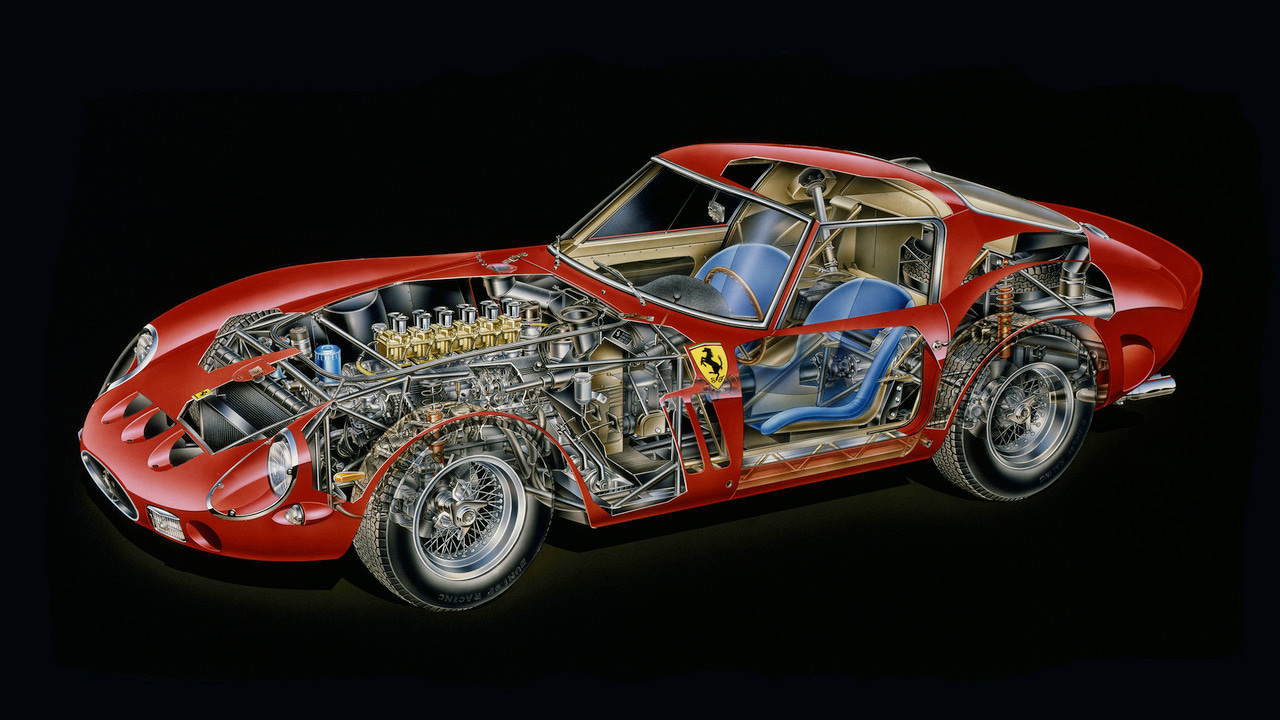The Ferrari 250 GTO: A Masterpiece of Automotive History
With only 36 units ever produced, the 250 GTO has become one of the most coveted and expensive cars in the world, commanding prices that soar into the tens of millions of dollars at auctions.
The Ferrari 250 GTO is not just a car; it's a legend in the world of automotive history. Known for its exquisite design, remarkable engineering, and unmatched performance, the 250 GTO represents the pinnacle of Ferrari's craftsmanship during the 1960s.
With only 36 units ever produced, the 250 GTO has become one of the most coveted and expensive cars in the world, commanding prices that soar into the tens of millions of dollars at auctions. This feature delves into the history, design, engineering, cultural impact, and unique properties that make the Ferrari 250 GTO a true icon.
The Origins of the Ferrari 250 GTO
The 250 GTO was born out of Ferrari's desire to dominate the world of GT racing. In the early 1960s, Ferrari was already a powerhouse in motorsport, but the competition was fierce, particularly from companies like Jaguar and Aston Martin. To maintain its supremacy, Ferrari needed a new car that could outperform its rivals on the track.
The 250 GTO was designed to meet the regulations of the FIA’s Group 3 Grand Touring Car category. It was based on the Ferrari 250 GT SWB (Short Wheelbase), but it featured significant modifications to improve aerodynamics, handling, and performance. The project was led by Giotto Bizzarrini, a brilliant engineer who had previously worked on the Ferrari 250 Testa Rossa. However, after Bizzarrini left Ferrari in 1961 due to a dispute with Enzo Ferrari, Mauro Forghieri and Sergio Scaglietti took over the project, finalizing the design and engineering of the 250 GTO.
Design and Bodywork
The design of the Ferrari 250 GTO is a masterpiece of automotive aesthetics. The body was crafted by Scaglietti, who used lightweight aluminum to create a sleek, aerodynamic shape that was both beautiful and functional. The car's lines are a perfect blend of elegance and aggression, with a low, sweeping nose, a long bonnet, and a short, truncated tail. The Kammback rear end was designed to reduce drag and improve stability at high speeds, a crucial factor in racing.
One of the most distinctive features of the 250 GTO is its trio of air intakes on the front hood, which not only gave the car a menacing look but also served a practical purpose by cooling the engine. The rounded, curvaceous fenders and the smooth, flowing roofline added to the car's allure, making it one of the most beautiful Ferraris ever produced.
The interior of the 250 GTO was spartan, focused on functionality rather than luxury. The dashboard was minimalist, with only the essential gauges and switches necessary for racing. The seats were lightweight and supportive, designed to keep the driver securely in place during high-speed cornering.
Engineering and Performance
At the heart of the Ferrari 250 GTO was its legendary engine, the Tipo 168/62 Colombo V12. This 3.0-liter engine was a masterpiece of engineering, delivering 300 horsepower at 7,500 RPM. The V12 engine featured six twin-choke Weber carburetors, a dry-sump lubrication system, and a five-speed manual transmission, which was a significant upgrade from the four-speed gearboxes used in previous models. The engine's power delivery was smooth and linear, allowing the 250 GTO to accelerate from 0 to 60 mph in just 5.4 seconds and reach a top speed of 174 mph, astonishing figures for the early 1960s.
The 250 GTO's chassis was a modified version of the 250 GT SWB's, featuring a tubular steel frame that provided both rigidity and lightness. The suspension was also upgraded, with independent front suspension using double wishbones and coil springs, and a live rear axle with semi-elliptical leaf springs and radius arms. This setup allowed the 250 GTO to handle with precision and agility, making it a formidable competitor on both the track and the road.
The brakes were large, ventilated discs on all four wheels, which provided excellent stopping power, essential for a car with such high performance. The combination of lightweight construction, powerful engine, and advanced suspension made the 250 GTO a joy to drive, with handling characteristics that were both predictable and exhilarating.
Unique Properties and Rarity
One of the most remarkable aspects of the Ferrari 250 GTO is its rarity. Only 36 units were ever produced between 1962 and 1964, including 33 Series I cars, three Series II cars, and three additional models that were re-bodied with different styling. This limited production run has contributed to the car's immense value and desirability among collectors.
Each 250 GTO was hand-built, with subtle differences between individual cars, making each one unique. The cars were also continuously developed and improved during their production run, with modifications made to the bodywork, suspension, and engine based on feedback from racing. This continuous evolution ensured that the 250 GTO remained competitive throughout its racing career.
The car's success on the track is another factor that sets it apart. The 250 GTO dominated GT racing in the early 1960s, winning numerous championships and races, including the Tour de France Automobile, the 12 Hours of Sebring, and the 24 Hours of Le Mans. Its racing pedigree has only added to its mystique and allure.
Pop Culture and Iconic Status
The Ferrari 250 GTO has transcended the world of motorsport to become a pop culture icon. Its striking design and storied history have made it a favorite in movies, television, and even video games. The car has appeared in films such as "The Love Bug" (1968), where it was driven by the villainous Peter Thorndyke, and "Vanilla Sky" (2001), where it was featured in a dream sequence starring Tom Cruise.
The 250 GTO has also been immortalized in numerous books, documentaries, and magazines, cementing its status as one of the most famous cars in the world. Its high-profile owners, including celebrities like Ralph Lauren, Nick Mason of Pink Floyd, and fashion mogul Ralph Lauren, have further enhanced its aura of exclusivity and glamour.
The car's value has skyrocketed over the years, with auction prices regularly breaking records. In 2018, a 1963 Ferrari 250 GTO sold for a staggering $70 million, making it the most expensive car ever sold at auction. This astronomical price reflects not only the car's rarity and performance but also its significance as a cultural and automotive icon.
Specialty Features and Engineering Innovations
The Ferrari 250 GTO was a car ahead of its time, featuring several engineering innovations that set it apart from its contemporaries. One of the most significant advancements was the use of wind tunnel testing during its development. This was a relatively new technique in the early 1960s, and Ferrari's use of it demonstrated their commitment to creating a car with exceptional aerodynamic properties.
The car's lightweight construction was another key feature. By using aluminum for the bodywork and carefully selecting materials for other components, Ferrari managed to keep the car's weight to just over 2,000 pounds. This focus on weight reduction contributed to the car's agility and performance on the track.
The 250 GTO also featured a rear-mounted transaxle, which helped to improve weight distribution and handling. This setup was unusual for the time and demonstrated Ferrari's willingness to push the boundaries of automotive design and engineering.
The car's aerodynamics were further enhanced by the addition of a rear spoiler, a feature that was not commonly seen on road cars at the time. This spoiler helped to increase downforce, improving stability at high speeds and making the car more competitive in racing.
Legacy and Influence
The legacy of the Ferrari 250 GTO extends far beyond its success on the racetrack. The car has influenced generations of automotive designers and engineers, serving as a benchmark for performance, design, and engineering excellence. Many of Ferrari's subsequent models, including the 288 GTO, F40, and LaFerrari, have drawn inspiration from the 250 GTO's design and engineering principles.
The 250 GTO's influence can also be seen in the broader automotive industry. Its combination of beauty, performance, and exclusivity has set the standard for what a supercar should be, inspiring countless other manufacturers to create their own high-performance, limited-production models.
Conclusion
The Ferrari 250 GTO is more than just a car; it's a symbol of excellence in design, engineering, and performance. Its rarity, racing pedigree, and timeless beauty have made it one of the most desirable and valuable cars in the world. Whether on the track, in a museum, or in the hands of a fortunate collector, the 250 GTO continues to captivate and inspire, solidifying its place as one of the greatest cars ever made.
STREAMING DEAL FROM PARAMOUNT +
For a limited time, Paramount+ annual plans start at $2.50/mo. for 12 months using promo code FALL50. Stream the NFL on CBS live and more! Don't drop the ball—this special offer ends September 23. Billed annually. Terms and conditions apply.
Stream the NFL on CBS and watch your local game live every week! Plus, catch featured national games including the Thanksgiving matchup and the postseason.
Don't miss another snap. Take advantage of this limited time offer and stream the NFL on CBS live on Paramount+. Redeem now!
CLICK HERE FOR LIMITED TIME OFFER
ACT NOW! For a limited time, Paramount+ annual plans start at $2.50/mo. for 12 months using promo code FALL50.
Take advantage of this limited time offer and stream the NFL on CBS live on Paramount+. Redeem now!
Everyday your story is being told by someone. Who is telling your story? Who are you telling your story to?
Email your sustainable story ideas, professional press releases or petro-powered podcast submissions to thecontentcreationstudios(AT)gmail(DOT)com.
#thecrudelife promotes a culture of inclusion and respect through interviews, content creation, live events and partnerships that educate, enrich, and empower people to create a positive social environment for all, regardless of age, race, religion, sexual orientation, or physical or intellectual ability.
MORE FROM THE CRUDE LIFE
Please click that ♡ button, share, and subscribe.
Please share the links on social media.
Thank you thank you thank you for your engagement and support.
If you have a news tip, press release, guest suggestion or other content concepts, please email thecontentcreationstudios(AT)gmail(DOT)com
This post was brought to you in part by one of The Crude Life’s fantastic sponsors, please consider supporting their services or learning more about their organization by clicking on the banner below.
Blockchain For Energy (B4E)
The Blockchain for Energy (B4E) consortium provides its members with forward thinking learnings and solutions. It collaboratively drives digital transformation by providing members with opportunities to accelerate their digitalization journey.
Through collective synergies, B4E seeks to resolve, reinvent, and transform the industry’s standard ways of working with external parties.
Blockchain for Energy is a safe venue to create transformational change – for the energy industry – by the energy industry. Current B4E members and collaborators include Chesapeake Energy, Chevron, ConocoPhillips, Devon Energy, ExxonMobil, Repsol, Saudi Aramco, Schlumberger, Enovate AI, Emerson ZEDI, Hedera, GBBC/IWA and Tolam Earth.












